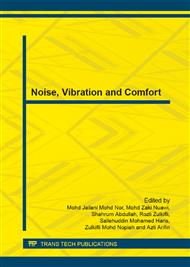p.102
p.107
p.113
p.119
p.125
p.130
p.138
p.143
p.151
Assessment of Environmental Noise and Air Quality in Critical Areas at UiTM Engineering Complex
Abstract:
Excessive environmental noise and poor air quality can be adverse to human health, living comfort and the environment itself. Measurement of sound pressure levels and air quality in critical areas including libraries, campus areas, public parks and hospitals thus becomes necessary to monitor and mitigate existing noise levels. In a university environment, student activities will be less disrupted if the locations of the activities are sufficiently away from noise sources. The present study is intended to measure sound levels and air quality around the Engineering Complex, Universiti Teknologi Mara, Shah Alam. The measured data is compared with to acceptable sound pressure levels and air quality index specified by the Department of Environment (DOE), Malaysia. Sound pressure levels are measured using the Castle Sound Level Meter Type 6224 and air quality measurement was done by using the BW Gas Alert MicroClip XT device. Both measurements were conducted at five selected stations around the Engineering Complex for three times each weekday for five weeks. Results obtained indicated that sound levels at some locations and time zones are above the thresholds recommended by the DOE. The air quality is acceptable in most locations except the vicinity of a bus stop. With the growing number of students in the university and other factors like construction and redevelopment of existing roads, a continuously increasing noise situations and air pollution proportional to the traffic flow is inevitable.
Info:
Periodical:
Pages:
125-129
Citation:
Online since:
December 2013
Authors:
Price:
Сopyright:
© 2014 Trans Tech Publications Ltd. All Rights Reserved
Share:
Citation:


